Urban Public Space Safety Perception and the Influence of the Built Environment from a Female Perspective: Combining Street View Data and Deep Learning
Abstract
1. Introduction
2. Literature Review
2.1. Measuring the Subjective Dimension of Safety for Women
2.2. Built Environment Features and Extraction
2.3. Safety Perception: Ranking and Analysis
3. Materials and Methods
3.1. Research Area
3.2. Data Source
3.3. Research Methodology
3.3.1. Evaluating Women’s Safety Perception in Public Spaces
- (1)
- Gist feature extraction
- (2)
- RankNet for safety perception ranking
3.3.2. Extracting Built Environment Features
3.3.3. Analyzing the Factors Influencing Women’s Safety Perception
- (1)
- OLS and GWR analysis
- (2)
- Clustering analysis
4. Results
4.1. Spatial Characteristics of Women’s Safety Perception in Public Spaces
4.2. Built Environment Features of Public Spaces in Wuhan
4.3. The Impact of Built Environment Features on Women’s Safety Perception in Public Spaces
5. Discussion
- (1)
- Consideration of vegetation design: In urban public space planning and design, careful attention should be given to the density and height of vegetation. As the modeling shows, the GVI negatively influenced women’s safety perception. That is, excessive vegetation coverage can contribute to the perception of potential danger and diminish safety. Therefore, areas with high vegetation coverage require enhanced management and maintenance.
- (2)
- Emphasis on spatial openness rather than visual diversity: The spatial openness of public spaces indicated by the SVF has a greater impact on enhancing women’s safety perception compared to the visual diversity of the streetscape. Spacious, well-lit, and orderly streets can effectively improve women’s safety perception.
- (3)
- Appropriate management of motor vehicles: According to empirical analysis, there are different impacts of the MVR on women’s safety perception in different parts of the city. In the outer urban ring and on branch roads, motor vehicles may not necessarily be perceived as negative factors affecting street safety. Introducing speed reduction measures on branch roads can help to mitigate the sense of insecurity caused by high vehicle speeds.
- (4)
- Context-specific strategies: Since the landscape composition varies across different urban areas, strategies to enhance female safety perception should be tailored to the specific characteristics of each area.
6. Conclusions
Author Contributions
Funding
Data Availability Statement
Conflicts of Interest
References
- Wronkowski, A. Discovering the meaning of contemporary urban squares for its users—A case study of Poznan, Poland. Humanit. Soc. Sci. Commun. 2024, 11, 1000. [Google Scholar] [CrossRef]
- Ramírez, T.; Ricardo, H.; Hans, L.; Tomás, R. Measuring heterogeneous perception of urban space with massive data and machine learning: An application to safety. Landsc. Urban Plan. 2021, 208, 104002. [Google Scholar] [CrossRef]
- O’Brien, E.A. Publics* and woodlands in England: Well-being, local identity, social learning, conflict and management, Forestry. Int. J. For. Res. 2005, 78, 321–336. [Google Scholar] [CrossRef]
- Steinmetz, N.M.; Austin, D.M. Fear of Criminal Victimization on a College Campus: A Visual and Survey Analysis of Location and Demographic Factors. Am. J. Crim. Justice 2014, 39, 511–537. [Google Scholar] [CrossRef]
- Madge, C. Public Parks and the Geography of Fear. Tijdschr. Voor Econ. En Soc. Geogr. 1997, 88, 237–250. [Google Scholar] [CrossRef]
- Roy, S.; Ajay, B. Safe in the City? Negotiating safety, public space and the male gaze in Kolkata, India. Cities 2021, 117, 103321. [Google Scholar] [CrossRef]
- Sadeghi, A.R.; Jangjoo, S. Women’s preferences and urban space: Relationship between built environment and women’s presence in urban public spaces in Iran. Cities 2022, 126, 103694. [Google Scholar] [CrossRef]
- Godden, J.O.; Oreopoulos, D.G. Fixing Broken Windows. Hum. Health Care Int. 1997, 13, 5. [Google Scholar]
- Seaforth, W. Towards woman-friendly cities. Habitat Debate 2002, 8, 1–3. [Google Scholar]
- Grantham, R. Space and Place: The Perspective of Experience. Contemp. Sociol. 1978, 7, 513. [Google Scholar] [CrossRef]
- Li, X.; Xu, F.; Gao, H.; Liu, F.; Lyu, X. A Frequency Domain Feature-Guided Network for Semantic Segmentation of Remote Sensing Images. IEEE Signal Process. Lett. 2024, 31, 1369–1373. [Google Scholar] [CrossRef]
- Zhao, C.; Liu, C.; Lai, Z. Multi-scale gist feature manifold for building recognition. Neurocomputing 2011, 74, 2929–2940. [Google Scholar] [CrossRef]
- Li, K. Research on the Factors Influencing the Spatial Quality of High-Density Urban Streets: A Framework Using Deep Learning, Street Scene Images, and Principal Component Analysis. Land 2024, 13, 1161. [Google Scholar] [CrossRef]
- Polko, P.; Kimic, K. Gender as a factor differentiating the perceptions of safety in urban parks. Ain Shams Eng. J. 2021, 13, 101608. [Google Scholar] [CrossRef]
- Day, K. Being Feared: Masculinity and Race in Public Space. Environ. Plan. A Econ. Space 2006, 38, 569–586. [Google Scholar] [CrossRef]
- Wyant, B.R. Multilevel Impacts of Perceived Incivilities and Perceptions of Crime Risk on Fear of Crime: Isolating Endogenous Impacts. J. Res. Crime Delinq. 2008, 45, 39–64. [Google Scholar] [CrossRef]
- Adısönmez, U.C. What is the Human Security Approach and How the Phenomenon Contributed to the International Security Agenda: Canadian and Japanese Paradigms. J. Secur. Strateg. 2016, 12, 1–29. [Google Scholar]
- McCormack, G.R.; Rock, M.; Toohey, A.M.; Hignell, D. Characteristics of urban parks associated with park use and physical activity: A review of qualitative research. Health Place 2010, 16, 712–726. [Google Scholar] [CrossRef]
- Guedes, I.; Moreira, S.; Cardoso, C.S. The Urban Security Image Database (USID): Development and validation of an image dataset for experimental studies on fear of crime. J. Exp. Criminol. 2023, 19, 465–485. [Google Scholar] [CrossRef]
- Sreetheran, M.; Van Den Bosch, C.C.K. A socio-ecological exploration of fear of crime in urban green spaces—A systematic review. Urban For. Urban Green. 2014, 13, 1–18. [Google Scholar] [CrossRef]
- De Nadai, M.; Xu, Y.; Letouzé, E.; González, M.C.; Lepri, B. Socio-economic, built environment, and mobility conditions associated with crime: A study of multiple cities. Sci. Rep. 2020, 10, 13871. [Google Scholar] [CrossRef]
- Sampson, R.J.; Groves, W.B. Community structure and crime: Testing social-disorganization theory. Am. J. Sociol. 1989, 94, 774–802. [Google Scholar] [CrossRef]
- Mak, B.K.L.; Jim, C.Y. Examining fear-evoking factors in urban parks in Hong Kong. Landsc. Urban Plan. 2018, 171, 42–56. [Google Scholar] [CrossRef]
- Moghadam, S.N.; Rafieian, M. What did urban studies do for women? A systematic review of 40 years of research. Habitat Int. 2019, 92, 102047. [Google Scholar] [CrossRef]
- Sampaio, C.R.A.; Sampaio, S.P.Y.; Yamada, M.; Ogita, M.; Arai, H. Urban-rural differences in physical performance and health status among older Japanese community-dwelling women. J. Clin. Gerontol. Geriatr. 2012, 3, 127–131. [Google Scholar] [CrossRef][Green Version]
- Ogwumike, O.; Kaka, B.; Adegbemigun, O.; Abiona, T. Health-related and socio-demographic correlates of physical activity level amongst urban menopausal women in Nigeria. Maturitas 2012, 73, 349–353. [Google Scholar] [CrossRef]
- Hancock, C.; Blanchard, S.; Chapuis, A. Banlieusard, e.s. Claiming a right to the City of Light: Gendered violence and spatial politics in Paris. Cities 2018, 76, 23–28. [Google Scholar] [CrossRef]
- Fabula, S.; Judit, T. Violations of the right to the city for women with disabilities in peripheral rural communities in Hungary. Cities 2018, 76, 52–57. [Google Scholar] [CrossRef]
- Krenichyn, K. Women and physical activity in an urban park: Enrichment and support through an ethic of care. J. Environ. Psychol. 2004, 24, 117–130. [Google Scholar] [CrossRef]
- Young, I.M. On Female Body Experience: “Throwing like a Girl” and Other Essays; Oxford University Press: Oxford, UK, 2005. [Google Scholar]
- Moser, C.O.N. Mainstreaming women’s safety in cities into gender-based policy and programmes. Gend. Dev. 2012, 20, 435–452. [Google Scholar] [CrossRef]
- Van de Pol, L.; Kuijpers, E. Poor Women’s Migration to the City: The Attraction of Amsterdam Health Care and Social Assistance in Early Modern Times. J. Urban Hist. 2005, 32, 44–60. [Google Scholar] [CrossRef]
- Das, D.; Safini, H. Water Insecurity in Urban India: Looking Through a Gendered Lens on Everyday Urban Living. Environ. Urban. ASIA 2018, 9, 178–197. [Google Scholar] [CrossRef]
- Salesses, P.; Schechtner, K.; Hidalgo, C.A. The Collaborative Image of The City: Mapping the Inequality of Urban Perception. PLoS ONE 2013, 8, e68400. [Google Scholar] [CrossRef]
- Dubey, A.; Nikhil, N.; Devi, P.; Ramesh, R.; Hidalgo, C.A. Deep Learning the City: Quantifying Urban Perception at a Global Scale. In Computer Vision–ECCV 2016: 14th European Conference, Amsterdam, The Netherlands, 11–14 October 2016, Proceedings, Part I 14; Springer International Publishing: Cham, Switzerland, 2016. [Google Scholar]
- Wang, C.; Wang, L.; Gu, T.; Hao, E.; Chen, Y.; Zhang, H. Evaluating Smart Community Development in China from the Perspective of Residents’ Sense of Safety: An Analysis Using Criteria Importance through Intercriteria Correlation and Fuzzy Comprehensive Evaluation Approaches. Land 2024, 13, 1434. [Google Scholar] [CrossRef]
- Less, E.L.; McKee, P.; Toomey, T.; Nelson, T.; Erickson, D.; Xiong, S.; Jones-Webb, R. Matching study areas using Google Street View: A new application for an emerging technology. Eval. Program Plan. 2015, 53, 72–79. [Google Scholar] [CrossRef]
- Ewing, R. Characteristics, Causes, and Effects of Sprawl: A Literature Review. In Urban Ecology; Springer: Boston, MA, USA, 2008. [Google Scholar]
- Tang, J.; Long, Y. Measuring visual quality of street space and its temporal variation: Methodology and its application in the Hutong area in Beijing. Landsc. Urban Plan. 2019, 191, 103436. [Google Scholar] [CrossRef]
- Ma, X.; Ma, C.; Ma, C.; Xi, Y.; Yang, R.; Peng, N.; Zhang, C.; Ren, F. Measuring human perceptions of streetscapes to better inform urban renewal: A perspective of scene semantic parsing. Cities 2021, 110, 103086. [Google Scholar] [CrossRef]
- Li, X.; Cai, B.Y.; Ratti, C. Using Street-level Images and Deep Learning for Urban Landscape studies. Landsc. Archit. Front. 2018, 6, 20–29. (In Chinese) [Google Scholar] [CrossRef]
- Li, X.; Xu, F.; Lyu, X.; Gao, H.; Tong, Y.; Cai, S.; Li, S.; Liu, D. Dual attention deep fusion semantic segmentation networks of large-scale satellite remote-sensing images. Int. J. Remote Sens. 2021, 42, 3583–3610. [Google Scholar] [CrossRef]
- Salesses, M.P. Place Pulse: Measuring the Collaborative Image of the City. Master’s Thesis, Massachusetts Institute of Technology, Cambridge, MA, USA, 2013. [Google Scholar]
- Gu, Y.; Hu, Y.; Shi, H. Research on Perception Evaluation of Street Environment Safety in Old Residential Area Based on Street View Picture. Urban Environ. Des. 2022, 6, 317–323. (In Chinese) [Google Scholar]
- Li, X.; Yan, H.; Wang, Z.; Wang, B. Evaluation of Road Environment Safety Perception and Analysis of Influencing Factors Combining Street View Imagery and Machine Learning. J. Geo-Inf. Sci. 2023, 25, 852–865. (In Chinese) [Google Scholar]
- Naik, N.; Philipoom, J.; Raskar, R.; Hidalgo, C. Streetscore–Predicting the Perceived Safety of One Million Streetscapes. In Proceedings of the IEEE Conference on Computer Vision and Pattern Recognition Workshops, Columbus, OH, USA; 2014; pp. 793–799. [Google Scholar]
- Yao, Y.; Liang, Z.; Yuan, Z.; Liu, P.; Bie, Y.; Zhang, J.; Wang, R.; Wang, J.; Guan, Q. A human-machine adversarial scoring framework for urban perception assessment using street-view images. Int. J. Geogr. Inf. Sci. 2019, 33, 2363–2384. [Google Scholar] [CrossRef]
- Ogawa, Y.; Oki, T.; Zhao, C.; Sekimoto, Y.; Shimizu, C. Evaluating the subjective perceptions of streetscapes using street-view images. Landsc. Urban Plan. 2024, 247, 105073. [Google Scholar] [CrossRef]
- Xu, J.; Xiong, Q.; Jing, Y.; Xing, L.; An, R.; Tong, Z.; Liu, Y.; Liu, Y. Understanding the nonlinear effects of the street canyon characteristics on human perceptions with street view images. Ecol. Indic. 2023, 154, 110756. [Google Scholar] [CrossRef]
- Li, X.; Zhang, C.; Li, W. Does the Visibility of Greenery Increase Perceived Safety in Urban Areas? Evidence from the Place Pulse 1.0 Dataset. ISPRS Int. J. Geo-Inf. 2015, 4, 1166–1183. (In Chinese) [Google Scholar] [CrossRef]
- Fotheringham, A.; Brunsdon, C.; Charlton, M. Geographically Weighted Regression: The Analysis of Spatially Varying Relationships; John Wiley & Sons: Hoboken, NJ, USA, 2002; Volume 13. [Google Scholar]
- Dziauddin, M.F. Estimating land value uplift around light rail transit stations in Greater Kuala Lumpur: An empirical study based on geographically weighted regression (GWR). Res. Transp. Econ. 2019, 74, 10–20. [Google Scholar] [CrossRef]
- Yang, W.; Yang, R.; Zhou, S. The spatial heterogeneity of urban green space inequity from a perspective of the vulnerable: A case study of Guangzhou, China. Cities 2022, 130, 103855. [Google Scholar] [CrossRef]
- Lin, S.; Liu, X.; Wang, T.; Li, Z. Revisiting entrepreneurial governance in China’s urban redevelopment: A case from Wuhan. Urban Geogr. 2022, 44, 1520–1540. [Google Scholar] [CrossRef]
- Tsochantaridis, I.; Joachims, T.; Hofmann, T.; Altun, Y.; Singer, Y. Large Margin Methods for Structured and Interdependent Output Variables. J. Mach. Learn. Res. 2005, 6, 1453–1484. [Google Scholar]
- Li, J.; Zeng, H.; Xiao, C.; Ouyang, C.; Liu, H. Listwise learning to rank method combining approximate NDCG ranking indicator with Conditional Generative Adversarial Networks. Pattern Recognit. 2024, 179, 31–37. [Google Scholar] [CrossRef]
- Li, H. A Short Introduction to Learning to Rank. IEICE Trans. Inf. Syst. 2011, 94, 1854–1862. [Google Scholar] [CrossRef]
- Burges, C.; Shaked, T.; Renshaw, E.; Lazier, A.; Deeds, M.; Hamilton, N.; Hullender, G. Learning to rank using gradient descent. In Proceedings of the 22nd International Conference on Machine Learning, Bonn, Germany, 7–11 August 2005. [Google Scholar]
- Song, Q.; Liu, A.; Yang, S.Y. Stock portfolio selection using learning-to-rank algorithms with news sentiment. Neurocomputing 2017, 264, 20–28. [Google Scholar] [CrossRef]
- Ye, Y.; Zhang, Z.; Zhang, X.; Zeng, W. Human-scale Quality on Streets: A Large-scale and Efficient Analytical Approach Based on Street View Images and New Urban Analytical Tools. Urban Plan. Int. 2019, 34, 18–27. [Google Scholar] [CrossRef]
- Bivand, R.; Müller, W.G.; Reder, M. Power calculations for global and local Moran’s I. Comput. Stat. Data Anal. 2009, 53, 2859–2872. [Google Scholar] [CrossRef]
- Anselin, L. Local Indicators of Spatial Association—LISA. Geogr. Anal. 1995, 27, 93–115. [Google Scholar] [CrossRef]
- Long, J.; Shelhamer, E.; Darrell, T. Fully Convolutional Networks for Semantic Segmentation. IEEE Trans. Pattern Anal. Mach. Intell. 2015, 39, 640–651. [Google Scholar]
- Chen, J.; Luo, F. A Survey of Image Semantic Segmentation Algorithm Based on Deep Learning. Acad. J. Sci. Technol. 2023, 5, 13–14. [Google Scholar] [CrossRef]
- Liu, Y.; Yuan, Y.; Xing, H.; Meng, Y.; Niu, T. The Applicability of Street View Images to Identify Urban Poverty in the Central Urban Region of Guangzhou. Trop. Geogr. 2020, 40, 919–929. (In Chinese) [Google Scholar]
- Ma, R.; Huang, A.; Cui, H.; Yu, R.; Peng, X. Spatial heterogeneity analysis on distribution of intra-city public electric vehicle charging points based on multi-scale geographically weighted regression. Travel Behav. Soc. 2023, 35, 100725. [Google Scholar] [CrossRef]
- Pang, R.; Teng, F.; Wei, Y. A GWR-Based Study on Dynamic Mechanism of Population Urbanization in Jilin Province. Sci. Geogr. Sin. 2014, 34, 1210–1217. (In Chinese) [Google Scholar]
- Gu, H.; Meng, X.; Shen, T.; Cui, N. Spatial variation of the determinants of China’s urban floating population’s settlement intention. Acta Geogr. Sin. 2020, 75, 240–254. (In Chinese) [Google Scholar]
- Jia, J.; Zhang, X.; Huang, C.; Luan, H. Multiscale analysis of human social sensing of urban appearance and its effects on house price appreciation in Wuhan, China. Sustain. Cities Soc. 2022, 81, 103844. [Google Scholar] [CrossRef]
- Lee, K.H.; Luan, S.; Lee, J.R.; Chun, S.; Heo, J. Geographically varying associations between mentally unhealthy days and social vulnerability in the USA. Public Health 2023, 222, 13–20. [Google Scholar] [CrossRef]
- Ikotun, A.M.; Absalom, E.E.; Abualigah, L.; Abuhaija, B.; Jia, H. K-means clustering algorithms: A comprehensive review, variants analysis, and advances in the era of big data. Inf. Sci. 2023, 622, 178–210. [Google Scholar] [CrossRef]
- Zhang, F.; Fan, Z.; Kang, Y.; Hu, Y.; Ratti, C. “Perception bias”: Deciphering a mismatch between urban crime and perception of safety. Landsc. Urban Plan. 2021, 207, 104003. [Google Scholar] [CrossRef]
- Skår, M. Forest dear and forest fear: Dwellers’ relationships to their neighborhoods forest. Landsc. Urban Plan. 2010, 98, 110–116. [Google Scholar] [CrossRef]
- Liang, X.; Zhao, T.; Biljecki, F. Revealing spatio-temporal evolution of urban visual environments with street view imagery. Landsc. Urban Plan. 2023, 237, 104802. [Google Scholar] [CrossRef]
- Gargiulo, I.; Garcia, X.; Benages-Albert, M.; Martinez, J.A.; Pfeffer, K.; Vall-Casas, P. Women’s safety perception assessment in an urban stream corridor: Developing a safety map based on qualitative GIS. Landsc. Urban Plan. 2020, 198, 103779. [Google Scholar] [CrossRef]
- Burattini, C.; Bisegna, F.; De Santoli, L. Street luminance and night-time walking comfort: A new perspective for the urban lighting design. J. Urban Des. 2024, 1–19. [Google Scholar] [CrossRef]
- Davoudian, N.; Raynham, P. What do pedestrians look at night? Light. Res. Technol. 2012, 44, 438–448. [Google Scholar] [CrossRef]

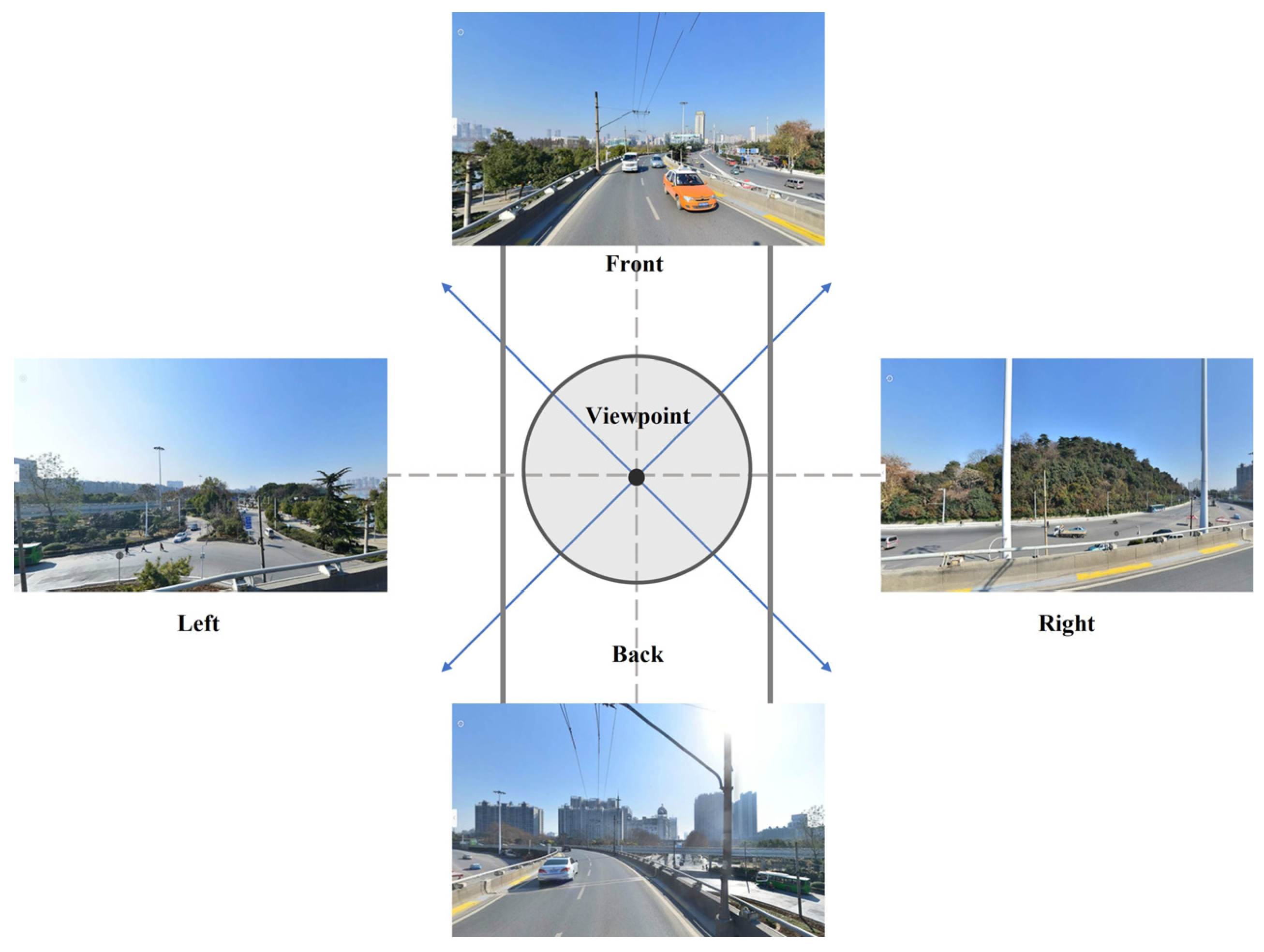


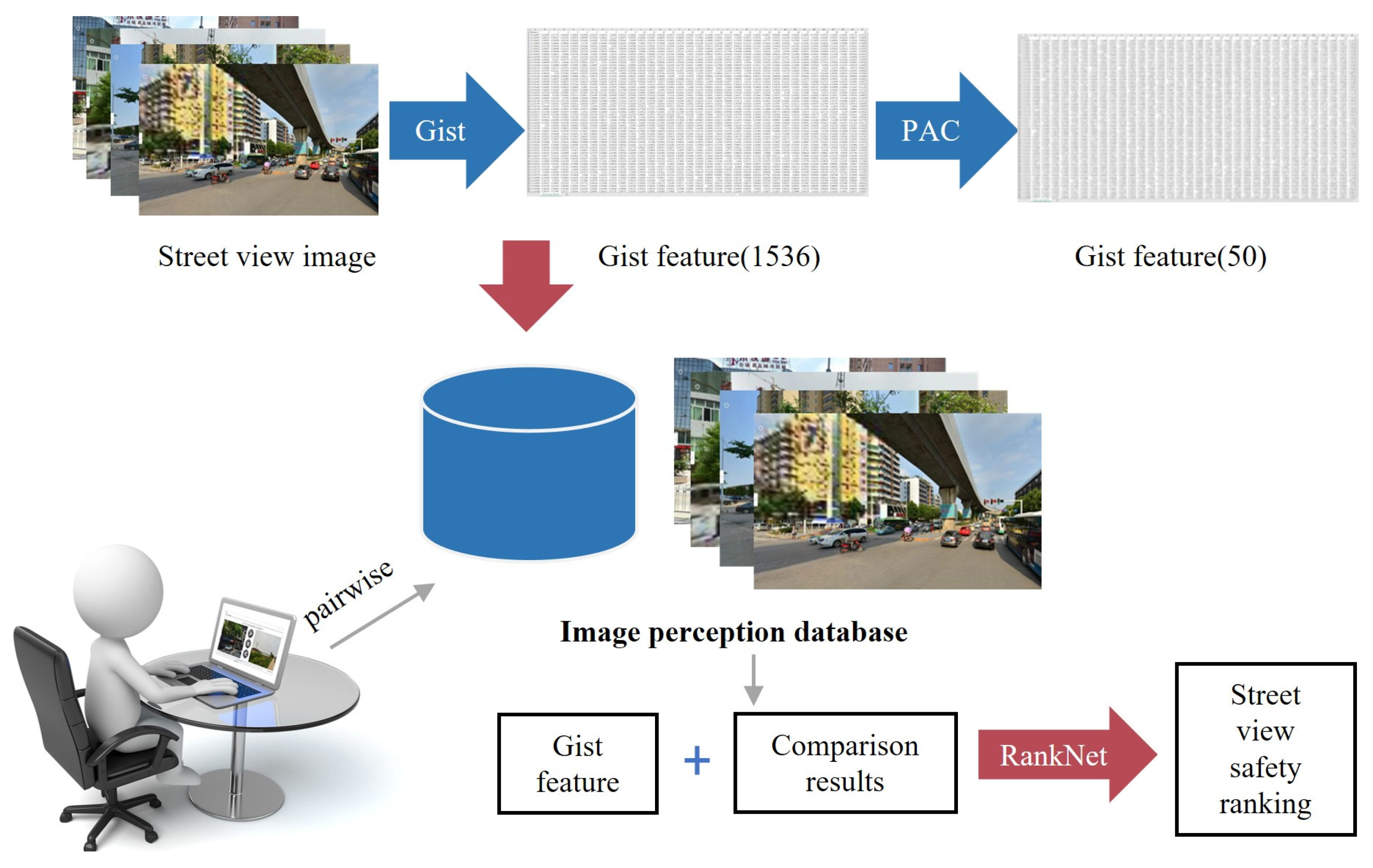
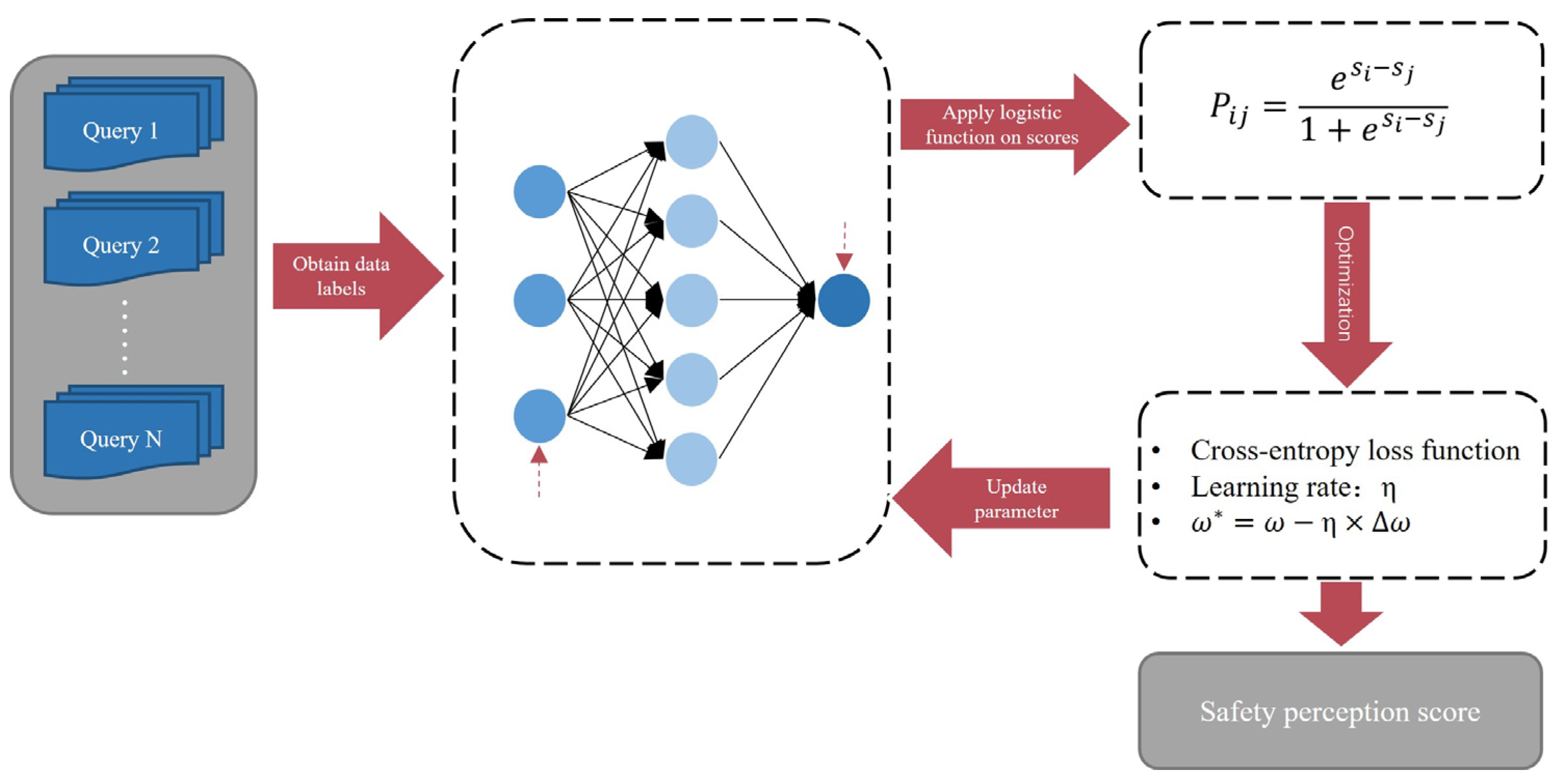
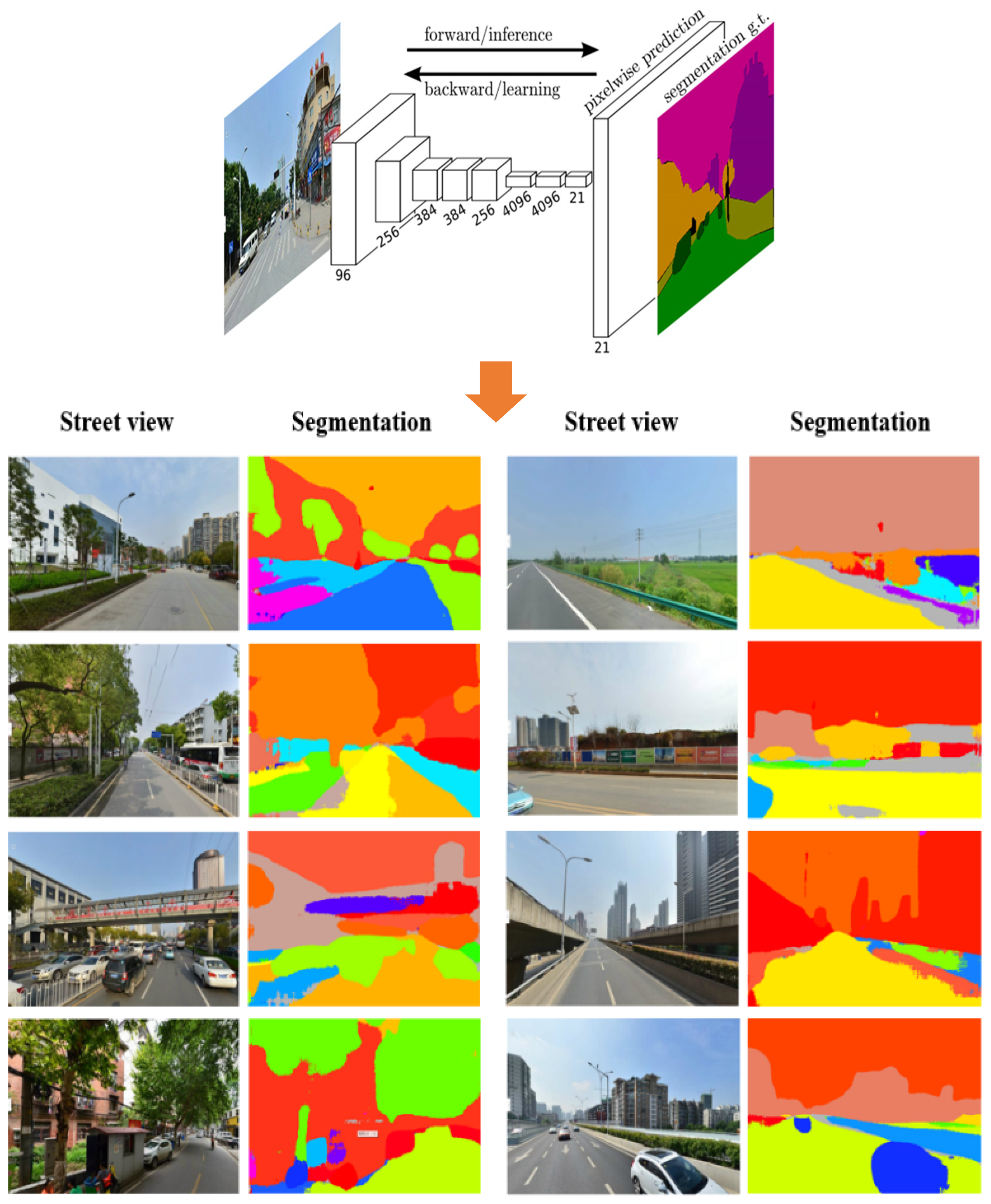

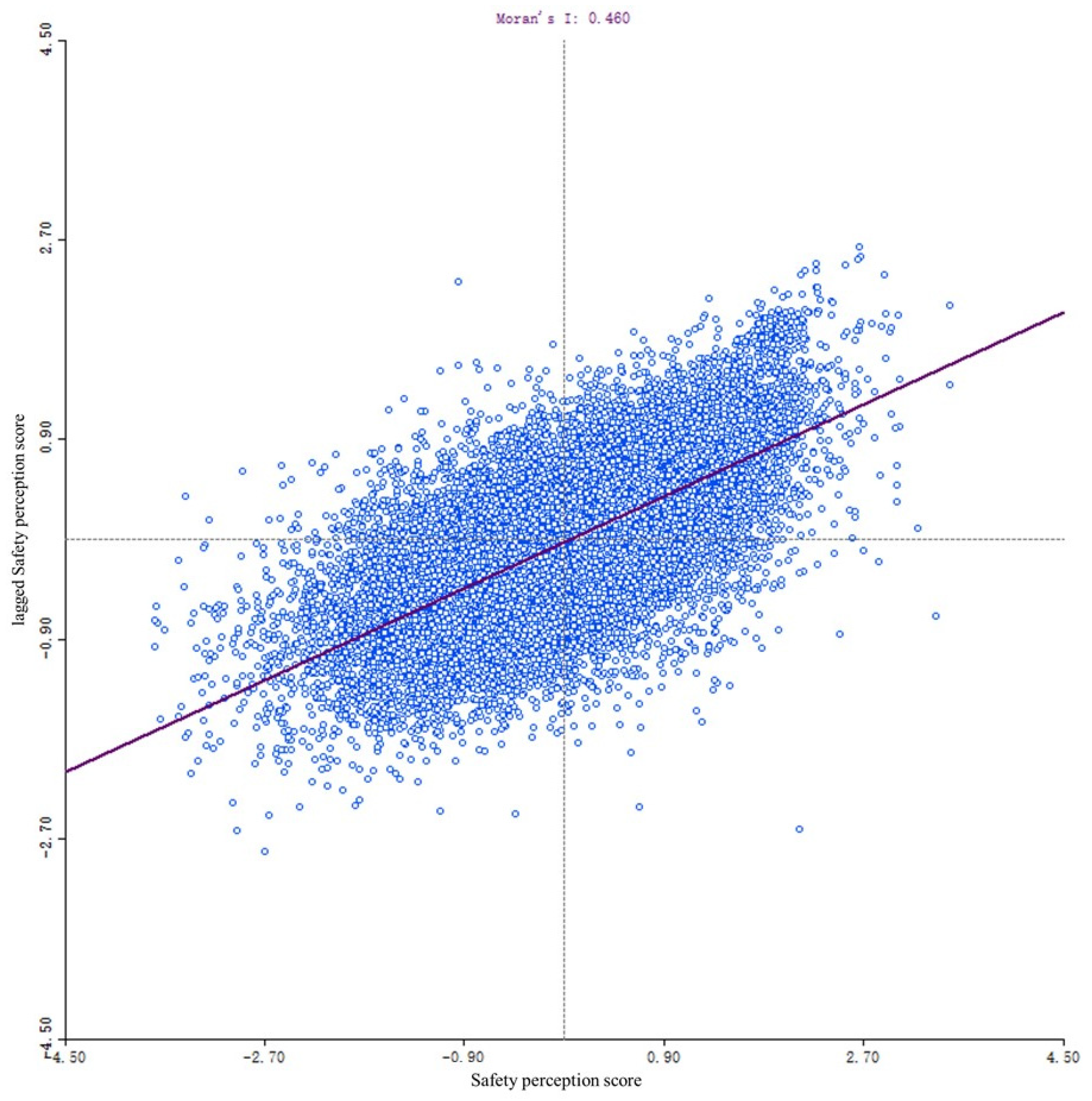
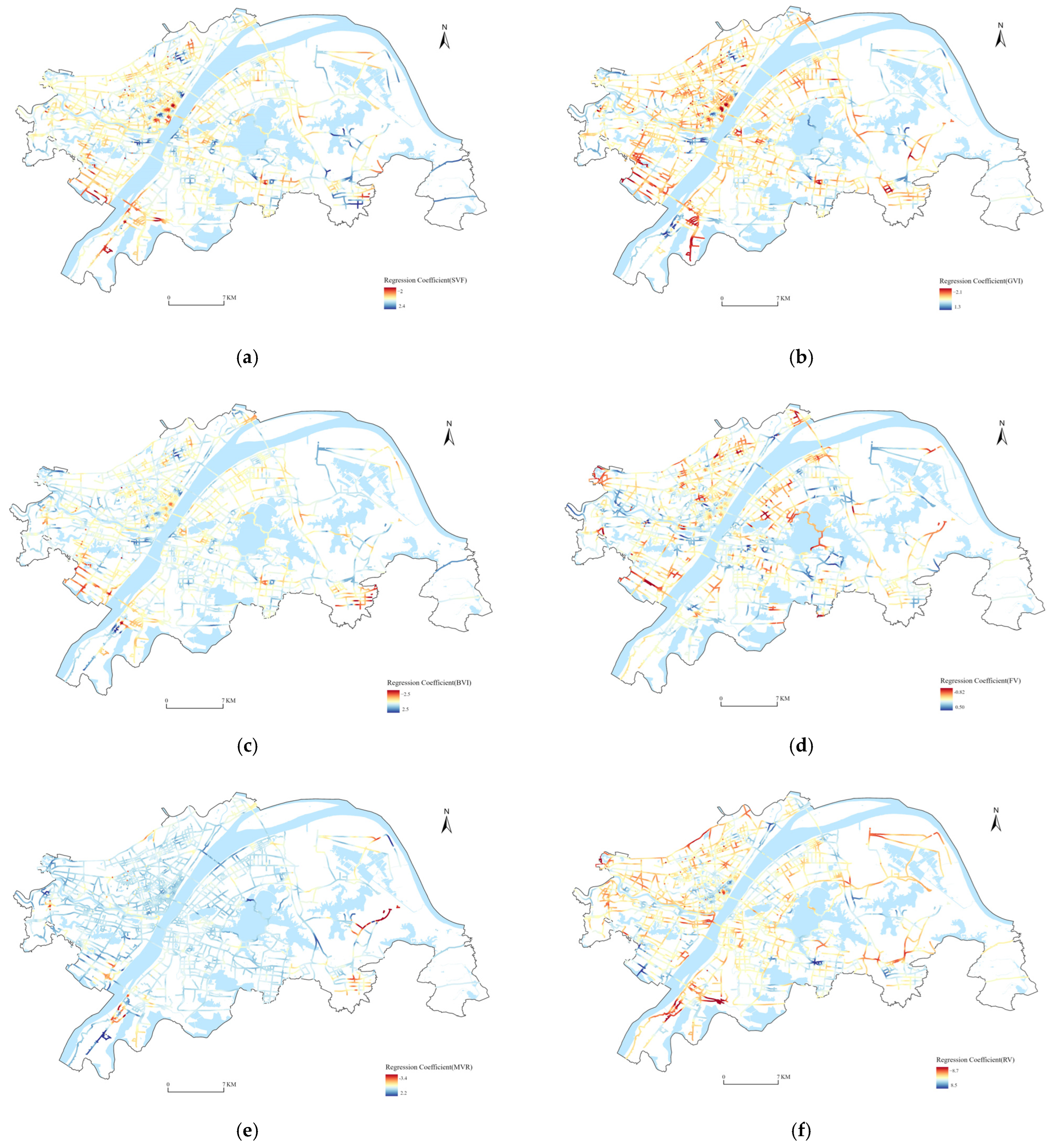
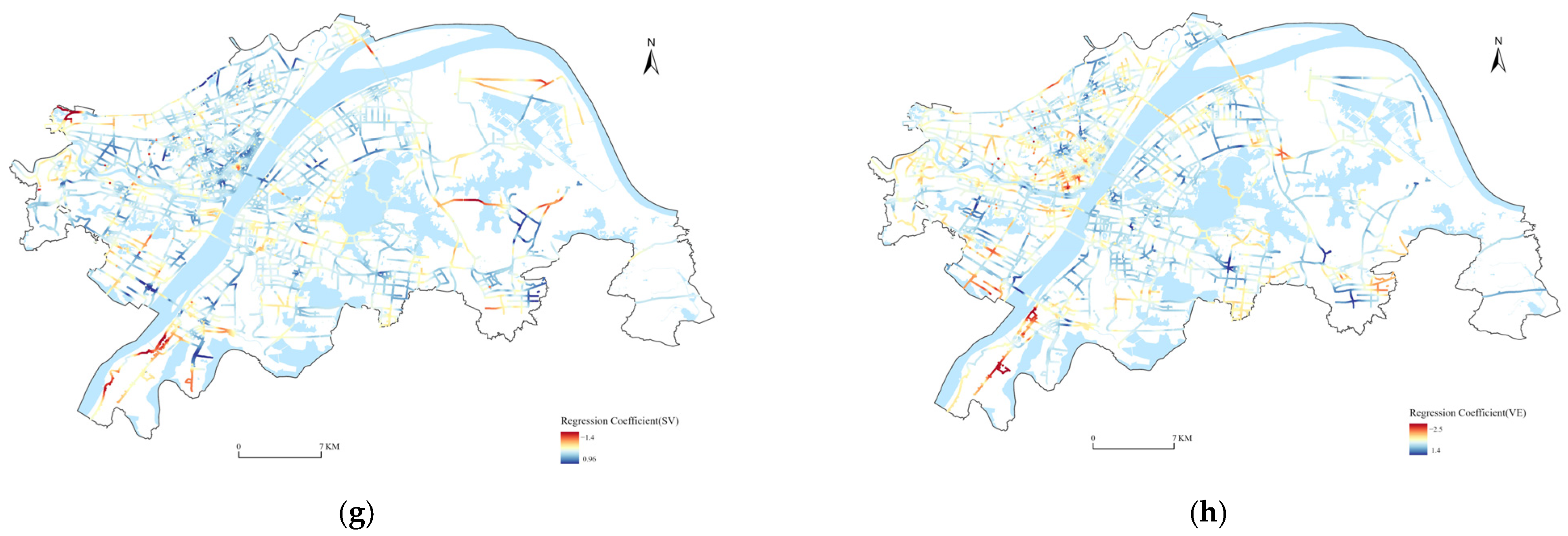
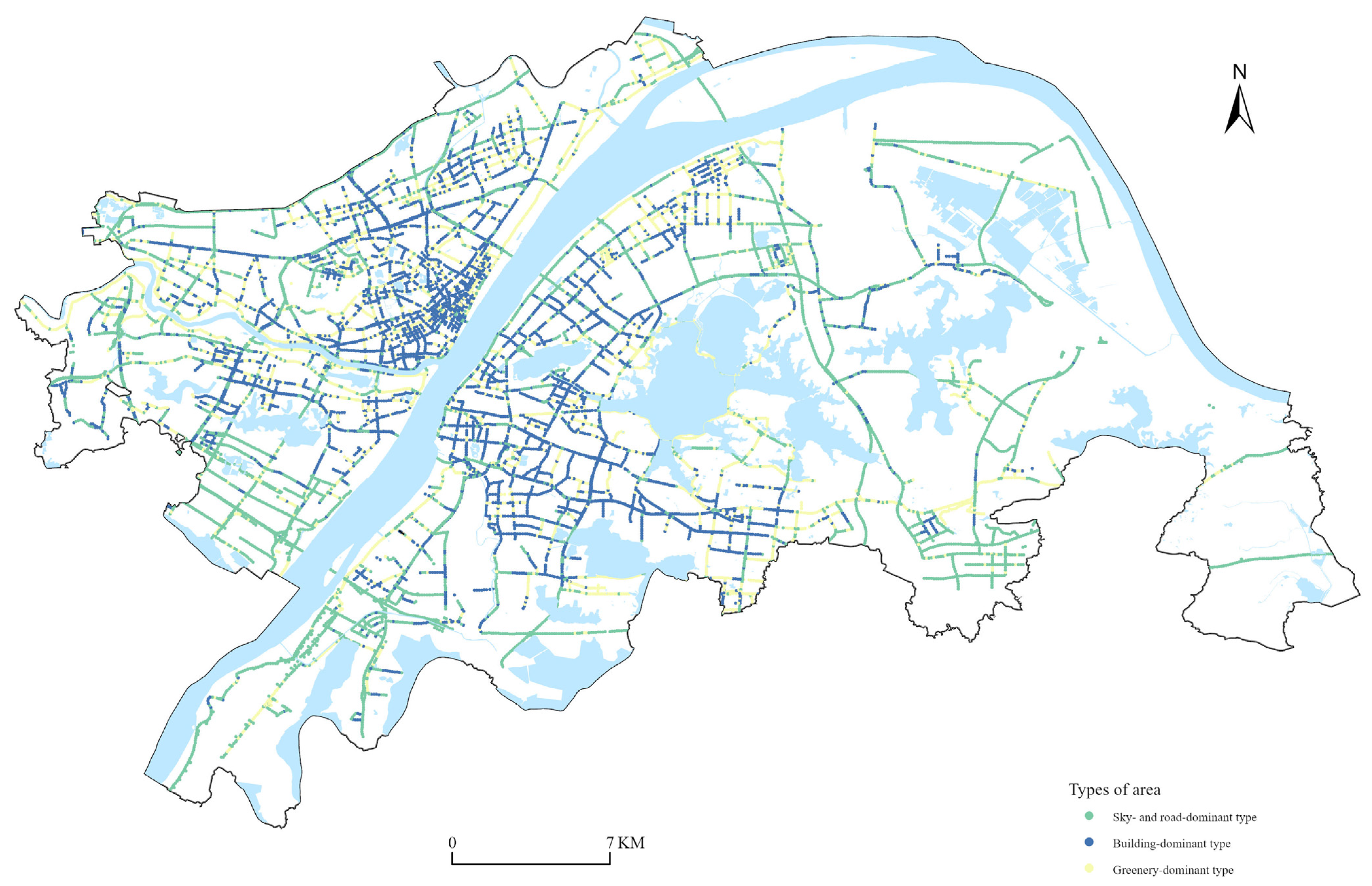
| Variables | Explanations | Measures | |
|---|---|---|---|
| Local index | Green View Index (GVI) | The average proportion of vegetation (including trees, grass, three-dimensional greening, etc.) in the street view image [3]. | is vegetation/sky/construction/ vehicle/facility/total pavement/roadway pixels; represents the map of the street viewpoint; is the total number of pixels in a street view image. |
| Sky View Factor (SVF) | An index for the openness of streets that reflects the degree of visible sky [4,5]. | ||
| Building View Index (BVI) | The average of the proportion of buildings (buildings, structures, and walls) in the street view images [5]. | ||
| Motor vehicle occurrence rate (MVR) | The average proportion of pixels in the four images of vehicles in the street view image, which reflects the probability of vehicle occurrence [5]. | ||
| Facility visibility (FV) | The proportion of pixels of street furniture, municipal facilities, billboards, and other street facilities in the total pixels of the street view. | ||
| Sidewalk visibility (SV) | The average proportion of pixels of the sidewalk in the street view image [5]. | ||
| Roadway visibility (RV) | The average of the pixel proportion of the four images in the street view image [5]. | ||
| Global index | Visual Entropy (VE) | Information can be used to reflect the visual complexity of the street landscape [5]. | is univariate gray-level entropy; is the probability that a grayscale appears in the image. |
| Variable | Mean | Std | Min | Median | Max |
|---|---|---|---|---|---|
| SVF | 26.99% | 0.1467 | 0 | 26.02% | 70.59% |
| GVI | 14.51% | 0.1346 | 0 | 10.64% | 83.52% |
| SV | 3.08% | 0.0328 | 0 | 2.01% | 26.80% |
| BVI | 21.14% | 0.1456 | 0 | 19.55% | 82.53% |
| VE | 0.9055 | 0.0663 | 0.0667 | 0.9183 | 0.9815 |
| MVR | 3.49% | 0.0382 | 0 | 2.33% | 33.76% |
| FV | 0.89% | 0.0144 | 0 | 0.43% | 24.30% |
| RV | 18.28% | 0.0772 | 0 | 18.93% | 38.74% |
| Variable | Coefficient | St. Error | t-Statistic | Probability | VIF |
|---|---|---|---|---|---|
| CONSTANT | 0.499879 | 0.000051 | 9709.477272 | 0 | ----- |
| SVF | 0.001502 | 0.000045 | 33.454552 | 0 | 4.291136 |
| GVI | −0.00352333 | 0.000043 | −72.995931 | 0 | 3.350295 |
| SV | −0.001303 | 0.000116 | −11.265931 | 0 | 1.424575 |
| BVI | −0.000247 | 0.000046 | −5.585939 | 0 | 4.441621 |
| VE | −0.000641 | 0.000055 | −11.692733 | 0 | 1.307091 |
| MVR | −0.000467 | 0.000094 | −4.975198 | 0 | 1.273709 |
| FV | −0.001875 | 0.000236 | −7.944481 | 0 | 1.149447 |
| RV | −0.0074 | 0.000048 | −15.392393 | 0 | 1.363754 |
| Variable | Est. | SE | t (Est/SE) | p-Value |
|---|---|---|---|---|
| Intercept | 0 | 0.005 | 0 | 1 |
| SVF | 0.313 | 0.009 | 33.455 | 0 |
| GVI | −0.604 | 0.008 | −72.996 | 0 |
| SV | −0.061 | 0.005 | −11.266 | 0 |
| BVI | −0.053 | 0.01 | −5.586 | 0 |
| VE | −0.06 | 0.005 | −11.693 | 0 |
| MVR | −0.025 | 0.005 | −4.975 | 0 |
| FV | −0.038 | 0.005 | −7.944 | 0 |
| RV | −0.081 | 0.005 | −15.392 | 0 |
| Variable | Mean | STD | Min | Median | Max |
|---|---|---|---|---|---|
| Intercept | −0.126 | 0.438 | −4.405 | −0.105 | 2.266 |
| SVF | 0.320 | 0.468 | −2.042 | 0.303 | 2.578 |
| GVI | −0.560 | 0.384 | −2.609 | −0.568 | 1.645 |
| SV | −0.025 | 0.195 | −1.658 | −0.020 | 0.951 |
| BVI | 0.011 | 0.391 | −2.379 | 0.020 | 2.071 |
| VE | −0.218 | 0.416 | −2.481 | −0.187 | 1.424 |
| MVR | −0.003 | 0.243 | −3.346 | 0.005 | 2.116 |
| FV | −0.049 | 0.152 | −0.748 | −0.041 | 0.735 |
| RV | −0.004 | 0.207 | −0.763 | −0.001 | 0.890 |
| Variable | Type 1 | Type 2 | Type 3 |
|---|---|---|---|
| SVF | 0.415237157 | 0.165589567 | 0.185132122 |
| GVI | 0.096951397 | 0.080326388 | 0.349499414 |
| SV | 0.015343475 | 0.037888162 | 0.046957979 |
| BVI | 0.115335061 | 0.356520532 | 0.131956194 |
| MVR | 0.023184624526 | 0.048074794016 | 0.033233683143 |
| FV | 0.008660779 | 0.010833077 | 0.006030477 |
| RV | 0.207131514 | 0.176946629 | 0.148069636 |
Disclaimer/Publisher’s Note: The statements, opinions and data contained in all publications are solely those of the individual author(s) and contributor(s) and not of MDPI and/or the editor(s). MDPI and/or the editor(s) disclaim responsibility for any injury to people or property resulting from any ideas, methods, instructions or products referred to in the content. |
© 2024 by the authors. Licensee MDPI, Basel, Switzerland. This article is an open access article distributed under the terms and conditions of the Creative Commons Attribution (CC BY) license (https://creativecommons.org/licenses/by/4.0/).
Share and Cite
Chen, S.; Lin, S.; Yao, Y.; Zhou, X. Urban Public Space Safety Perception and the Influence of the Built Environment from a Female Perspective: Combining Street View Data and Deep Learning. Land 2024, 13, 2108. https://doi.org/10.3390/land13122108
Chen S, Lin S, Yao Y, Zhou X. Urban Public Space Safety Perception and the Influence of the Built Environment from a Female Perspective: Combining Street View Data and Deep Learning. Land. 2024; 13(12):2108. https://doi.org/10.3390/land13122108
Chicago/Turabian StyleChen, Shudi, Sainan Lin, Yao Yao, and Xingang Zhou. 2024. "Urban Public Space Safety Perception and the Influence of the Built Environment from a Female Perspective: Combining Street View Data and Deep Learning" Land 13, no. 12: 2108. https://doi.org/10.3390/land13122108
APA StyleChen, S., Lin, S., Yao, Y., & Zhou, X. (2024). Urban Public Space Safety Perception and the Influence of the Built Environment from a Female Perspective: Combining Street View Data and Deep Learning. Land, 13(12), 2108. https://doi.org/10.3390/land13122108







